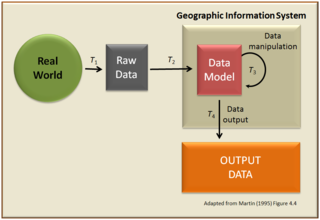Related Research Articles

A geographic information system (GIS) is a type of database containing geographic data, combined with software tools for managing, analyzing, and visualizing those data. In a broader sense, one may consider such a system to also include human users and support staff, procedures and workflows, body of knowledge of relevant concepts and methods, and institutional organizations.

A gazetteer is a geographical index or directory used in conjunction with a map or atlas. It typically contains information concerning the geographical makeup, social statistics and physical features of a country, region, or continent. Content of a gazetteer can include a subject's location, dimensions of peaks and waterways, population, gross domestic product and literacy rate. This information is generally divided into topics with entries listed in alphabetical order.
A GIS software program is a computer program to support the use of a geographic information system, providing the ability to create, store, manage, query, analyze, and visualize geographic data, that is, data representing phenomena for which location is important. The GIS software industry encompasses a broad range of commercial and open-source products that provide some or all of these capabilities within various information technology architectures.
William C. Kirby is T. M. Chang Professor of China Studies and Spangler Family Professor of Business Administration at Harvard University. He is the chairman of the Harvard China Fund, Faculty Chair of the Harvard Center Shanghai, Harvard's first University-wide center located outside the United States, former Director of Fairbank Center for Chinese Studies, former Chair of the History Department and the former Dean of the Harvard Faculty of Arts and Sciences, where he oversaw 10,000 students, 1,000 faculty members, 2,500 staff, and an annual budget of $1 billion and announced his resignation after a four-year tenure on January 27, 2006.
Participatory GIS (PGIS) or public participation geographic information system (PPGIS) is a participatory approach to spatial planning and spatial information and communications management.
Geospatial metadata is a type of metadata applicable to geographic data and information. Such objects may be stored in a geographic information system (GIS) or may simply be documents, data-sets, images or other objects, services, or related items that exist in some other native environment but whose features may be appropriate to describe in a (geographic) metadata catalog.
A historical geographic information system is a geographic information system that may display, store and analyze data of past geographies and track changes in time. It can be regarded as a tool for historical geography.
The Great Britain Historical GIS is a spatially enabled database that documents and visualises the changing human geography of the British Isles, although is primarily focussed on the subdivisions of the United Kingdom mainly over the 200 years since the first census in 1801. The project is currently based at the University of Portsmouth, and is the provider of the website A Vision of Britain through Time.
The National Historical Geographic Information System (NHGIS) is a historical GIS project to create and freely disseminate a database incorporating all available aggregate census information for the United States between 1790 and 2010. The project has created one of the largest collections in the world of statistical census information, much of which was not previously available to the research community because of legacy data formats and differences between metadata formats. The statistical and geographic data are disseminated free of charge through a sophisticated online data access system.
Traditional knowledge geographic information systems (GIS) are the data, techniques, and technologies designed to document and utilize local knowledges in communities around the world. Traditional knowledge is information that encompasses the experiences of a particular culture or society. Traditional knowledge GIS are more valuable than ordinary cognitive maps in that they express environmental and spiritual relationships among real and conceptual entities. They comprise a formidable toolset for use in cultural preservation, land rights disputes, natural resource management, and economic development.
A geographic data model, geospatial data model, or simply data model in the context of geographic information systems, is a mathematical and digital structure for representing phenomena over the Earth. Generally, such data models represent various aspects of these phenomena by means of geographic data, including spatial locations, attributes, change over time, and identity. For example, the vector data model represents geography as collections of points, lines, and polygons, and the raster data model represent geography as cell matrices that store numeric values. Data models are implemented throughout the GIS ecosystem, including the software tools for data management and spatial analysis, data stored in a variety of GIS file formats, specifications and standards, and specific designs for GIS installations.
Geographic Information Systems (GIS) are an increasingly important component of business, healthcare, security, government, trade, media, transportation and tourism industries and operations in China. GIS software is playing an increasing role in the way Chinese companies analyze and manage business operations.

Geospatial topology is the study and application of qualitative spatial relationships between geographic features, or between representations of such features in geographic information, such as in geographic information systems (GIS). For example, the fact that two regions overlap or that one contains the other are examples of topological relationships. It is thus the application of the mathematics of topology to GIS, and is distinct from, but complimentary to the many aspects of geographic information that are based on quantitative spatial measurements through coordinate geometry. Topology appears in many aspects of geographic information science and GIS practice, including the discovery of inherent relationships through spatial query, vector overlay and map algebra; the enforcement of expected relationships as validation rules stored in geospatial data; and the use of stored topological relationships in applications such as network analysis. Spatial topology is the generalization of geospatial topology for non-geographic domains, e.g., CAD software.
A prosopographical network is a system which represents a historical group made up by individual actors and their interactions within a delimited spatial and temporal range. The network science methodology offers an alternative way of analyzing the patterns of relationships, composition and activities of people studied in their own historical context. Since prosopography examines the whole of a past society, its individuals who made it up, and its structure, this independent science of social history uses a collective study of biographies of a well-defined group, in a multiple career analysis, for collecting and interpreting relevant quantities of data, these same set of data can be employed for constructing a network of the studied group. Prosopographical network studies have emerged as a young and dynamic field in historical research; nevertheless, the category of prosopographical network is in its formative, initial phase and as a consequence it is hard to view as a stable and defined notion in history and beyond social network analysis. See also narrative network.

WorldMap is a web platform for creating, displaying, analyzing, and searching spatial data and other data forms across multiple disciplines.
The Harvard Laboratory for Computer Graphics and Spatial Analysis pioneered early cartographic and architectural computer applications that led to integrated geographic information systems (GIS). Some of the Laboratory's influential programs included SYMAP, SYMVU, GRID, CALFORM, and POLYVRT. The Laboratory's Odyssey project created a geographic information system that served as a milestone in the development of integrated mapping systems. The Laboratory influenced numerous computer graphic, mapping and architectural systems such as Intergraph, Computervision, and Esri.

The China Biographical Database (CBDB) is a relational database on Chinese historical figures from the 7th to 19th centuries. The database provides biographical information of approximately 360,000 individuals up till April 2015.
Zhou Zhenhe is a Chinese historical geographer and a distinguished senior professor at the Institute of Historical Geography of Fudan University in Shanghai. His main research interests are cultural and administrative geography and history of Sino-foreign cultural relations. He is the chief editor of the 13-volume General History of Chinese Administrative Divisions, published between 2007 and 2016.
Ge Jianxiong is a Chinese historical geographer. He is a professor and the former Director of the Institute of Historical Geography of Fudan University in Shanghai, and Director of the Fudan University Library. His research focus is on historical population movements and human geography. Ge is also a well-known public figure in China. He is a member of the Standing Committee of the Chinese People's Political Consultative Conference (CPPCC) and is on the Advisory Committee of the Shanghai Municipal Government.
Peter Kees Bol is an American historian and sinologist. He is the Charles H. Carswell Professor of East Asian Languages and Civilizations of Harvard University. Since 2013, he has been a Vice Provost of Harvard with oversight of HarvardX and the Harvard Initiative in Learning and Teaching (HILT). He is the founding director of the Harvard Center for Geographic Analysis, and also directs the China Historical Geographic Information System (CHGIS) and the China Biographical Database (CBDB) project.
References
- ↑ "PETER K. BOL". Harvard University. Retrieved 17 November 2017.
- ↑ Peter Bol; Jianxiong Ge (2005). "China Historical GIS". Historical Geography.
- ↑ Yongming Xu (2020). "Visualizing Classic Chinese Literature". In Hui Lin; Xinyue Ye (eds.). Spatial Synthesis: Computational Social Science and Humanities. Springer International Publishing. pp. 65–76. ISBN 9783030527341.